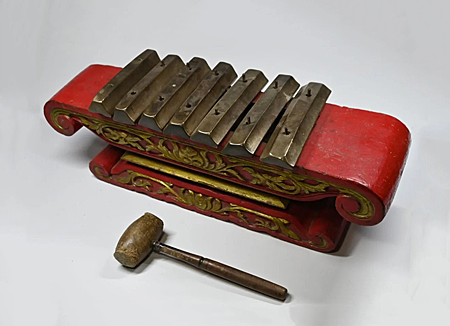
Owner: HWMC
Catalog#: 2AS-IDST-83
Metallophones / Xylophones
Java ‘Saron Panerus’ (Peking)
Java, Indonesia
Javanese
Bronze, wood, pigment
ca. 1950s
Length: 26 in; Height: 9 in; Depth: 8.5 in
Idiophones – Struck Idiophones – Metallophones
This saron panerus, also known by its nickname ‘peking,’ is an Indonesian melodic metallophone used in Javanese gamelan. It consists of seven nearly rectangular bronze bars/keys (wilah) in arch shape (where the bottom is flat, and the top is arched). These bars/keys set on a wooden trough resonator (rancakan kijingan). It is played by a performer seated with cross legs on the floor using a wooden mallet (tabuh) to strike the bars with one hand while the other hand is used to dampen the previous note by grasping the key.
There are basically three sizes, the smallest called saron panerus (nickname ‘peking’), the saron barung (sometimes just called ‘saron’), and the saron demung (often just called ‘demung’). This is the saron panerus (‘peking’) with the smallest size metal bars, however, the bars/keys of the saron panerus are much thicker than those of the saron barung and saron demung. Its pitches are one octave above the saron barung, and two octaves higher than the saron demung. There are two different types of tuning: laras sléndro and laras pélog. The slendro scale is an octave divided into five tones roughly equidistant pitches). The pelog scale consists of seven notes of varying intervals of which five are given principal stress.
Reference: Kunst, Jaap. 1968. Hindu-Javanese Musical Instruments. The Hague: Martinus Nijhoff; https://omeka-s.grinnell.edu/s/MusicalInstruments/item/1217
